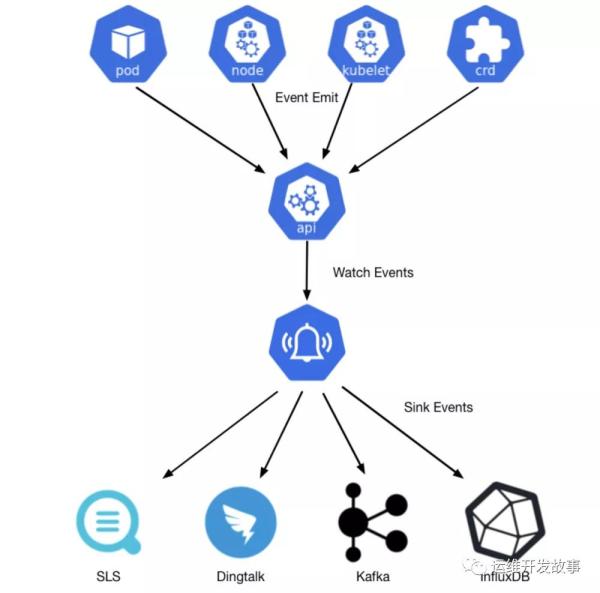您好,登录后才能下订单哦!
这篇文章主要介绍“Kube-Eventer的操作介绍”,在日常操作中,相信很多人在Kube-Eventer的操作介绍问题上存在疑惑,小编查阅了各式资料,整理出简单好用的操作方法,希望对大家解答”Kube-Eventer的操作介绍”的疑惑有所帮助!接下来,请跟着小编一起来学习吧!
kube-eventer是由阿里开源的k8s离线事件收集器,开源地址
https://github.com/AliyunContainerService/kube-eventer/blob/master/docs/en/webhook-sink.md
在Kubernetes中,事件分为两种,一种是Warning事件,表示产生这个事件的状态转换是在非预期的状态之间产生的;另外一种是Normal事件,表示期望到达的状态,和目前达到的状态是一致的。
我们以NPD的event来讲解。事件影响节点的临时性问题,但是它是对于系统诊断是有意义的。NPD就是利用kubernetes的上报机制,通过检测系统的日志(例如centos中journal),把错误的信息上报到kuberntes的node上。这些日志(例如内核日志)中噪音信息太多,NPD会提取其中有价值的信息,可以将这些信息生成离线事件。这样我就可以得到node上的时间,及时进行处理。
一个标准的Kubernetes事件有如下几个重要的属性,通过这些属性可以更好地诊断和告警问题。Namespace:产生事件的对象所在的命名空间。
Kind:绑定事件的对象的类型,例如:Node、Pod、Namespace、Componenet等等。
Timestamp:事件产生的时间等等。
Reason:产生这个事件的原因。Message: 事件的具体描述。

目前的sinks支持大致如下:
| Sink Name | Description |
|---|---|
| dingtalk | sink to dingtalk bot |
| sls | sink to alibaba cloud sls service |
| elasticsearch | sink to elasticsearch |
| honeycomb | sink to honeycomb |
| influxdb | sink to influxdb |
| kafka | sink to kafka |
| mysql | sink to mysql database |
| sink to wechat |
今天主要带来webhook的开挂技巧。首先看支持的参数:
level - Level of event (optional. default: Warning. Options: Warning and Normal)
namespaces - Namespaces to filter (optional. default: all namespaces,use commas to separate multi namespaces, namespace filter doesn't support regexp)
kinds - Kinds to filter (optional. default: all kinds,use commas to separate multi kinds. Options: Node,Pod and so on.)
reason - Reason to filter (optional. default: empty, Regexp pattern support). You can use multi reason fields in query.
method - Method to send request (optional. default: GET)
header - Header in request (optional. default: empty). You can use multi header field in query.
custom_body_configmap - The configmap name of request body template. You can use Template to customize request body. (optional.)
custom_body_configmap_namespace - The configmap namespace of request body template.
如果每个项目namespace与负责人是一一对应的,就可以根据configmap与sink关联起来。变更上线部署是最容易出现事件的时候,通过事件是可以快速的发现上线的镜像tag错误,镜像配置错误等问题。
首先configmap,通过custom_body_configmap的值来选择不同的配置文件。可以简单修饰一下,使其变得更加清晰。
添加加Cluster:name可以知道是哪个集群的event。
添加加"mentioned_list":["wangqin","@all"]可以@对应的负责人。
--- apiVersion: v1 data: content: >- {"msgtype": "text","text": {"content": "Cluster:name\nEventType:{{ .Type }}\nEventNamespace:{{ .InvolvedObject.Namespace }}\nEventKind:{{ .InvolvedObject.Kind }}\nEventObject:{{ .InvolvedObject.Name }}\nEventReason:{{ .Reason }}\nEventTime:{{ .LastTimestamp }}\nEventMessage:{{ .Message }}","mentioned_list":["wangqing","@all"]}} kind: ConfigMap metadata: name: custom-webhook-body namespace: nameapcesink是一个数组,可以加很多条。
主要说明用webhook向企业微信的的通知。注意reason是可以支持正则表达式的。通过configmap就一起完成了k8s机器的事件告警。
command: - "/kube-eventer" - "--source=kubernetes:https://kubernetes.default" ## .e.g,dingtalk sink demo - --sink=webhook:https://qyapi.weixin.qq.com/cgi-bin/webhook/send?key=xxxxxxx&level=Warning&reason=[^Unhealthy]&namespaces=xxxx&header=Content-Type=application/json&custom_body_configmap=custom-webhook-body0&custom_body_configmap_namespace=xxxx&method=POST - --sink=webhook:https://qyapi.weixin.qq.com/cgi-bin/webhook/send?key=xxxxxxx&level=Warning&reason=BackOff&namespaces=xxxx&header=Content-Type=application/json&custom_body_configmap=custom-webhook-body1&custom_body_configmap_namespace=xxxx&method=POST - --sink=webhook:https://qyapi.weixin.qq.com/cgi-bin/webhook/send?key=xxxxxxx&level=Warning&reason=Failed&namespaces=xxxx&header=Content-Type=application/json&custom_body_configmap=custom-webhook-body2&custom_body_configmap_namespace=xxxxx&method=POST
案列:
创建一个企业微信群的机器人。比如:https://qyapi.weixin.qq.com/cgi-bin/webhook/send?key=xxxxxxx。
apiVersion: apps/v1 kind: Deployment metadata: labels: name: kube-eventer name: kube-eventer namespace: namespace spec: replicas: 1 selector: matchLabels: app: kube-eventer template: metadata: labels: app: kube-eventer annotations: scheduler.alpha.kubernetes.io/critical-pod: '' spec: dnsPolicy: ClusterFirstWithHostNet serviceAccount: kube-eventer containers: - image: registry.aliyuncs.com/acs/kube-eventer-amd64:v1.2.0-484d9cd-aliyun name: kube-eventer command: - "/kube-eventer" - "--source=kubernetes:https://kubernetes.default" ## .e.g,dingtalk sink demo - --sink=webhook:https://qyapi.weixin.qq.com/cgi-bin/webhook/send?key=xxxxxxx&level=Warning&reason=[^Unhealthy]&namespaces=xxxx&header=Content-Type=application/json&custom_body_configmap=custom-webhook-body0&custom_body_configmap_namespace=xxxx&method=POST #- --sink=webhook:https://qyapi.weixin.qq.com/cgi-bin/webhook/send?key=xxxxxxx&level=Warning&reason=BackOff&namespaces=xxxx&header=Content-Type=application/json&custom_body_configmap=custom-webhook-body1&custom_body_configmap_namespace=xxxx&method=POST #- --sink=webhook:https://qyapi.weixin.qq.com/cgi-bin/webhook/send?key=xxxxxxx&level=Warning&reason=Failed&namespaces=xxxx&header=Content-Type=application/json&custom_body_configmap=custom-webhook-body2&custom_body_configmap_namespace=xxxxx&method=POST env: # If TZ is assigned, set the TZ value as the time zone - name: TZ value: "Asia/Shanghai" volumeMounts: - name: localtime mountPath: /etc/localtime readOnly: true - name: zoneinfo mountPath: /usr/share/zoneinfo readOnly: true resources: requests: cpu: 200m memory: 100Mi limits: cpu: 500m memory: 250Mi volumes: - name: localtime hostPath: path: /etc/localtime - name: zoneinfo hostPath: path: /usr/share/zoneinfo --- apiVersion: rbac.authorization.k8s.io/v1 kind: ClusterRole metadata: name: kube-eventer rules: - apiGroups: - "" resources: - events - configmaps verbs: - get - list - watch --- apiVersion: rbac.authorization.k8s.io/v1 kind: ClusterRoleBinding metadata: name: kube-eventer roleRef: apiGroup: rbac.authorization.k8s.io kind: ClusterRole name: kube-eventer subjects: - kind: ServiceAccount name: kube-eventer namespace: namespace --- apiVersion: v1 kind: ServiceAccount metadata: name: kube-eventer namespace: namespace --- apiVersion: v1 data: content: >- {"msgtype": "text","text": {"content": "Cluster:name\nEventType:{{ .Type }}\nEventNamespace:{{ .InvolvedObject.Namespace }}\nEventKind:{{ .InvolvedObject.Kind }}\nEventObject:{{ .InvolvedObject.Name }}\nEventReason:{{ .Reason }}\nEventTime:{{ .LastTimestamp }}\nEventMessage:{{ .Message }}","mentioned_list":["wangqing","@all"]}} kind: ConfigMap metadata: name: custom-webhook-body namespace: nameapce
这样就可以完成向谁告警,谁进行处理的简单分配。有了事件告警,可以及时发现服务问题与集群问题并进行修复。
到此,关于“Kube-Eventer的操作介绍”的学习就结束了,希望能够解决大家的疑惑。理论与实践的搭配能更好的帮助大家学习,快去试试吧!若想继续学习更多相关知识,请继续关注亿速云网站,小编会继续努力为大家带来更多实用的文章!
免责声明:本站发布的内容(图片、视频和文字)以原创、转载和分享为主,文章观点不代表本网站立场,如果涉及侵权请联系站长邮箱:is@yisu.com进行举报,并提供相关证据,一经查实,将立刻删除涉嫌侵权内容。